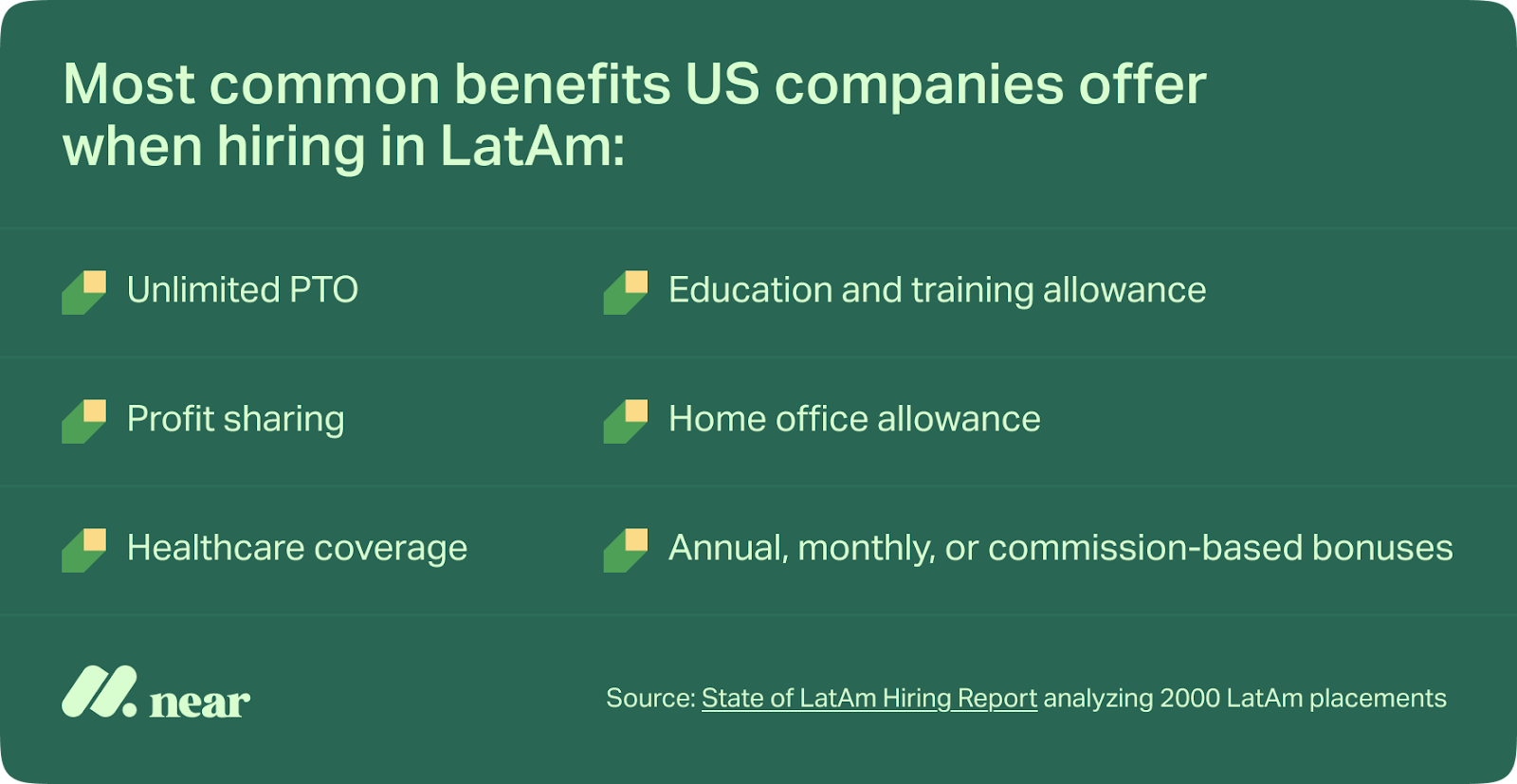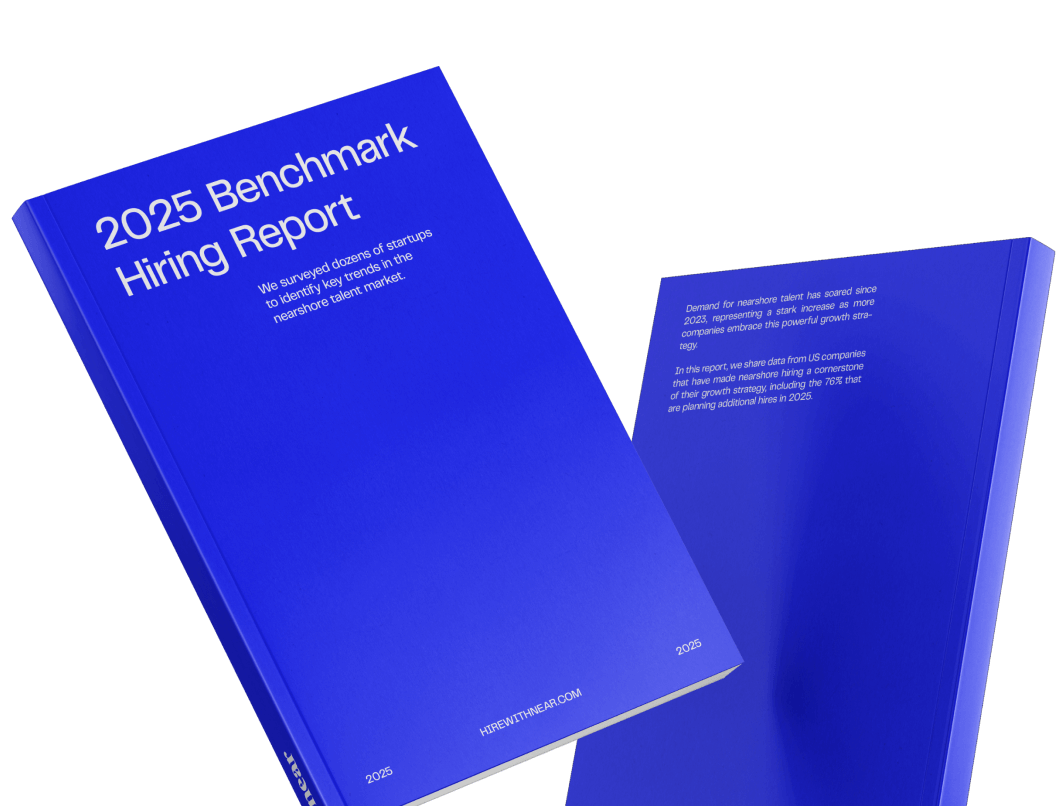Key Takeaways
- US companies are turning to Latin America to solve critical talent shortages and rising salary costs. With 75% of US employers struggling to find skilled workers and salaries increasing 3.6% annually, businesses are finding that LatAm offers access to qualified professionals they simply can't afford or find domestically.
- Hiring skilled professionals from Latin America (LatAm) offers significant cost savings, allowing businesses to reinvest savings into growth areas like R&D and marketing.
- Major US corporations like Microsoft, Amazon, and IBM have successfully built teams across Latin America for decades, creating a deep pool of professionals who already understand US business practices, communication styles, and quality standards—making the transition seamless for companies of all sizes.
A mid-sized tech company in Silicon Valley received additional investment and is preparing for rapid growth. It urgently needs to scale up its software development team.
Despite offering competitive salaries and a dynamic workplace, its HR department struggles to find the right talent. Candidates are either underqualified or snatched up by larger competitors with bigger pockets.
Frustrated and desperate to maintain momentum, the company’s leadership team begins exploring a once-unconventional solution: recruiting talent from Latin America (LatAm). Within weeks, they onboarded a talented team of developers, solving their hiring crisis.
This scenario is far from unique. Thousands of U.S. companies are turning to LatAm to address their workforce needs, driving a paradigm shift in how businesses approach recruitment.
Why Companies Are Looking Outside the U.S. for Talent
The shifting hiring landscape doesn’t have a single cause. It’s due to a convergence of factors that feed into and amplify each other.
Tight U.S. labor market and shortage of skilled workers for key roles
According to the U.S. Chamber of Commerce, there simply isn’t enough available labor to fill every vacant role in the U.S.:
Over the last two decades, job openings have largely increased, while the number of unemployed workers has decreased, ultimately leading to a labor shortage once the number of jobs openings in the country surpassed the number of available workers.
In ManpowerGroup’s survey of 40,413 employers in 42 countries, of those in the US, 75% reported struggling to find skilled talent.
Without the necessary skilled workforce, project deadlines slip, productivity drops, and companies find themselves unable to capitalize on emerging opportunities.
While this shortage doesn’t play out across all industries (e.g., the construction industry has a surplus of workers), the biggest shortage is being felt in financial, professional, and business services.
And these are exactly the types of roles that are remote-friendly and open up the possibility of hiring outside the US.
.webp)
Mounting financial pressure
The cost of hiring in the U.S. continues to rise, adding financial pressures on companies trying to attract top talent.
According to the U.S. Bureau of Labor Statistics, salaries for workers (private and public sectors) increased by 3.6% for the 12-month period ending in March 2025, following a 4.2% increase for the previous 12-month period.
Salaries remain well ahead of inflation, though there is quite a bit of variance across industries.
For many small and medium-sized enterprises (SMEs), these escalating salary demands can be unsustainable. The financial burden of high wages can sap resources that might otherwise be directed toward growth and innovation.
As a result, companies are increasingly motivated to look for cost-effective alternatives to hiring domestically.
High competition and low retention
The aftermath of “The Great Reshuffle,” where workers sought better-paying jobs with larger companies, has led to intense competition for top talent.
Again, SMEs in particular are feeling the squeeze, with high turnover costing these businesses as much as $3 billion each year.
The constant churn of employees is costly, disrupts team cohesion, and erodes company culture. It can mean the loss of institutional knowledge and a decrease in overall productivity.
For SMEs, which may not have the same level of resources as larger corporations, this high turnover rate can be especially destabilizing. So any hiring strategy that improves retention is welcome.
Why LatAm Is Becoming a Hotspot for Hiring Talent
Now that we’ve established the pressing challenges in the U.S. job market, let’s explore why LatAm has emerged as the go-to hiring destination.
Lower salary costs and higher retention rates
Salary expectations for skilled professionals in countries like Brazil, Mexico, and Argentina are significantly lower than those in the U.S due to lower average living costs.
For instance, a senior full-stack developer in the U.S. can command a salary of up to $245,000 per year. A comparable candidate in LatAm can be hired for $120,000.
Here’s a look at some other common roles and their salary discrepancies compared with U.S. hires.
.webp)
The attraction for U.S. companies isn’t just to cut costs. It’s to be able to afford the caliber of talent that may be out of reach in the U.S.
For example, the oil and gas startup Digital Wildcatters simply couldn’t afford to hire an outbound sales specialist locally, as the salary demands were way too high for their current structure.
By looking at the LatAm market — and with the help of us at Near (Hire With Near) — they found and hired a perfect candidate in just 26 days, saving $42,000 annually.
Their new hire was so effective at booking sales meetings that the company actually had to tell him to slow down. Now, they routinely fly him in for key meetings and conferences.
Plus, the savings from lower salaries can be reinvested into critical areas like:
- Research and development (R&D): Boost innovation by funding new projects and technologies.
- Marketing and sales: Enhance market reach and drive revenue growth.
- Employee benefits: Improve employee satisfaction and retention with better perks and development programs.
Our State of LatAm Hiring Report, which analyzed 2000 placements of LatAm professionals with 500 U.S. companies, found that companies save an average of $35,000 to $55,000 per hire compared to domestic hiring.
However, it’s not just the US-based company that benefits.
The report revealed that LatAm hires saw their salaries grow by up to 87% when switching to an equivalent role with a U.S. company. And that increase, paired with any benefits offered, results in them being 66.29% more likely to stay with the company than their U.S.-based counterparts.

Large talent pool of skilled candidates
While the U.S. faces a documented talent shortage, skilled professionals exist in significant numbers across Latin America, where countries have invested heavily in education, particularly in STEM.
According to the Georgetown Center for Security and Emerging Technology, Mexico has passed the U.S. in terms of the percentage of total graduates in STEM fields, with 26% of its graduates obtaining a STEM degree compared to 20% for the U.S. Brazil isn’t far behind with 17%.
Many Latin American professionals hold degrees from reputable institutions, such as Universidade de São Paulo (Brazil), Pontificia Universidad Católica de Chile, Tecnológico de Monterrey (Mexico), Universidad de Buenos Aires (Argentina), and Universidad Nacional Autónoma de México (Mexico), and have extensive experience in their respective industries.
English proficiency is also on the rise, especially among younger professionals looking for remote opportunities and in tech hubs like São Paulo, Buenos Aires, and Mexico City.
Argentina, for example, ranks 28th globally and second-highest in English proficiency within LatAm behind Suriname, categorized in the "High Proficiency" band by the EF English Proficiency Index 2024.
With access to a larger talent pool, U.S. companies can fill positions faster and with individuals who bring diverse perspectives and innovative solutions.
For example, Tribu, a San Antonio-based creative agency, couldn’t find someone with the right mix of graphic design and web development skills in their local candidate pool. They expanded their search to LatAm and hired the ideal candidate 24 days later.
It was a perfect fit. They not only got the mix of skills they were looking for but also saved $37,000 annually in overhead.
Aligned time zones
Time zone alignment between Latin America and the U.S. enables real-time collaboration, which is challenging with teams in Asia or Europe.
This alignment facilitates real-time communication and collaboration, which are essential for agile workflows and timely project execution.
Kordis, a fractional CFO services provider, initially tried to work with accountants and executive assistants from the Philippines when they realized they needed to save on salaries.
But a 12-hour time difference was too difficult to overcome. They faced unresponsive employees and invested valuable resources into trying to build communication solutions.
When they brought their search closer to home and started working with Near, they found a LatAm staff accountant with a Commerce degree from the University of Toronto, an Executive MBA in Financial Management, and five years of experience working remotely for U.S. companies.
Additionally, they found an executive assistant who had two degrees (in Business Administration and Psychology) and over 10 years of experience in similar roles. They are saving over $100,000 annually in salaries and no longer have to deal with the time zone difference.
Aligned time zones also create a better working environment for employees. A study by Harvard Business School of 12,038 employees of a multinational company across 48 countries backed up the commonly held belief that employees located in distant time zones from their co-workers are “especially likely to experience pressure to work non-traditional or nonlinear workdays.”
While working outside a “normal” workday may work well — and even be preferred — by some employees, for others, it may lead to burnout and eventually turnover.
The Harvard study found that the optimal arrangement for synchronous communication was to have teams located “on a North–South axis.” So, for example, although New York and São Paulo are geographically distant, “workers in each location pair will experience near-complete [business-hours overlap].”

Large U.S. companies have had a presence in LatAm for years
Major U.S. corporations (Microsoft, JP Morgan, Dell) have maintained physical operations in Latin America for decades, creating a deep pool of professionals experienced in U.S. business practices.
This long-standing presence means today's hiring landscape includes thousands of Latin American professionals who already understand U.S. work culture, communication styles, and business expectations.
Amazon alone employs thousands of professionals across Latin America in roles ranging from software development to supply chain management. These employees regularly collaborate with U.S.-based teams, participate in global projects, and maintain the same quality standards as their U.S. counterparts.
IBM and Cisco have expanded their presence in places like Argentina, tapping into the country’s skilled workforce for technological and business processes.
Today, a look at the “companies we work with” pages of recruitment firms specializing in LatAm remote hiring reveals a roster that includes many major NYSE- and NASDAQ-listed companies. These businesses are building distributed teams across the Americas to meet staffing needs and maintain operational momentum, further expanding the pool of LatAm professionals with experience collaborating with U.S. organizations.
Final Thoughts
The U.S. workforce is undergoing a fundamental transformation. Companies that once competed for talent within a 50-mile radius now find themselves in a marketplace where geographical boundaries have dissolved.
Latin America's emergence as a talent hub represents more than an economic opportunity — it signals a broader shift in how work gets done.
The region's decades-long relationship with U.S. corporations has created something unique: a workforce that combines lower costs with cultural familiarity, technical expertise with time zone alignment.
The implications extend beyond individual companies. As more businesses hire in LatAm, they're creating new models for collaboration, challenging assumptions about where talent can be found, and reshaping the competitive landscape.
The oil and gas startup that now flies its Latin American sales specialist to the U.S. for meetings. The creative agency in San Antonio whose web designer works from Buenos Aires. The fractional CFO firm whose accounting team spans from Mexico City to São Paulo.
These aren't outliers. They're early indicators of a new normal, where the question isn't whether to look beyond U.S. borders for talent, but how to do it effectively.
Ready to build your Latin American team?
While your competitors are still posting jobs on the same platforms and hoping for different results, you could be building distributed teams that combine top talent with sustainable economics.
At Near, we've helped over 700 US companies make this transition. We handle everything—from finding pre-vetted candidates who match your company culture to managing payroll and compliance.
Here's how it works: You tell us what you need. We present qualified candidates within 3 days. You only pay when you hire, and every placement comes with a 180-day replacement guarantee.
Schedule a call to discuss your hiring challenges
No commitments. No upfront costs. Just a conversation to explore how Latin American talent can help you scale faster and smarter.
%20(1).webp)












.png)






%20(1).png)
%20(1).png)
